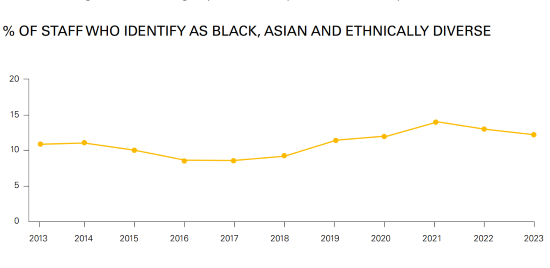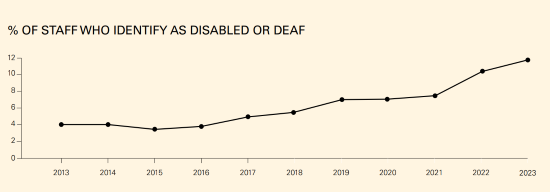
Photo: iStock/SeventyFour
Ethnic diversity of ACE workforce in decline
Arts Council England's annual report of 2022/23 registers a decrease in ethnic diversity of its staff, while percentage of disabled staff continues to rise.
The proportion of staff at Arts Council England (ACE) from Black, Asian, and ethnically diverse backgrounds has fallen for the second year.
Figures published in ACE's annual report for 2022/23 reveal a drop of more than one per cent for the last year from 13.5% in 2021/22 to 12.4% for 2022/23. The figure for 2021/22 was 14.3%. According to the 2021 census, 17.6% of the overall population is Black, Asian or from ethnically diverse backgrounds.
ACE has told Arts Professional that it is working to address the situation and has commissioned an independent review into inclusion at the organisation, the findings of which will be published later this year.
READ MORE:
- ACE refuses to release 'sensitive' race and disability documents
- Is ACE’s diversity strategy – and reporting – fit for purpose?
The drop in diversity in the ACE workforce follows a period of gradual progress between 2016 to 2021.

Source: Arts Council England Annual Report 2022/23
In recent years ACE has made diversity a key tenet of its mission. It currently requires National Portfolio Organisation to report on the diversity of their own workforces.
“We want the diversity of audiences, leaders, producers and creators of creativity and culture to reflect the diversity of contemporary England," it has previously said.
And the new National Portfolio, announced last November, saw a rise in Black, Asian and ethnically diverse-led organisations from 103 to 158.
Combined, this represents 8.4% of the total portfolio investment totalling £37.7m a year. The percentage of portfolio investment for such organisations was previously around 2.4%.
Centuries-long inequity
Amanda Parker, Director of Policy, Research & Communications at the Forward Institute, told Arts Professional that in light of ACE's 10-year Let's Create strategy being "built on diversity" it needs to make improvements.
She said that if its workforce was to reflect the communities in which its offices are located, then between a quarter and a third of its workforce would be of ethnically-diverse heritage.
"Does an arts organisation need Black staff to make sense of Black-led creative production? No.That's not what it's about," she said.
"We're in the business of creative expression of stories with universal resonance: we can all be open to the magic and beauty of other perspectives unlike our own.
"Do we need diversity of workforce to improve business practice and ensure our work resonates with our consumers, audiences, buyers? Absolutely yes.
"ACE knows this and has put diversity into Let's Create like a golden thread. It's vital that we all – including ACE – make the shift to improve creative and societal outcomes."
Growing at pace
ACE told Arts Professional that its workforce grew at pace while administering the Culture Recovery Fund and other new programmes, with new secondments and fixed-term contract roles created to support this.
The headcount at the organisation went from 586 in 2019/20 to 622 in 2020/21, 679 in 2021/22 and then reduced back to 643 in 2022/23.
ACE added that continuing to develop inclusion and creating an environment where everyone feels they belong is "very important to us".
"This recent drop in our [diversity] figures follows a sustained period of growth and we are focused on getting back on an upward trend," an ACE spokesperson said.
"We've set ourselves a target that 17% of our colleagues are from Black, Asian and ethnically diverse backgrounds.
"To help attract candidates from the broadest possible range of backgrounds we’ve introduced more skills-based recruitment, and reviewed the platforms we advertise on.
"Although we have more to do to increase representation across the board, the proportion of Black, Asian and ethnically diverse colleagues in a leadership position is now at 21%."
Legal challenge
The drop in diversity at ACE comes as the organisation faces legal proceedings in relation to alleged race discrimination.
Corynne Elliot – better known Mercury Music Prize-winning musician Speech Debelle – was employed as a Relationship Manager at ACE.
The employment tribunal is ongoing and neither ACE or Elliot have commented on the case.
Last year, ACE refused to release the minutes of its Race and Disability Advisory Group following a Freedom of Information (FOI) request from ArtsProfessional due to their "frank" and "sensitive" nature.
ACE argued that disclosure of the documents would create a "chilling effect", inhibit free and frank discussions in the future, and ultimately damage the quality of advice and deliberation, leading to poorer decision-making.
Disabled or deaf
While figures for Black, Asian and ethnically diverse staff continue to fall, ACE reports that the percentage of its staff who regard themselves to be disabled, deaf or neurodiverse has continued to rise.

Source: Arts Council England Annual Report 2022/23
For 2022/23 the figure was 12%, compared with 10.3% in 2021/22. For 2020/21 the percentage was 7.7.
Jo Verrent, Director of Unlimited, an arts commissioning programme which supports disabled artists, said: “It’s always brilliant to see an increase in statistics for the employment of disabled people within the cultural industries – but it’s important to remember the benchmark.
"The levels of disabled people in the population of the UK is somewhere between 20 – 25%, depending what statistics you use, so while having 12% of Arts Council England staff identify is good, there is still a way to go.
"It’s important also to remember the levels within the sector as a whole are just under half this. Arts Council’s own report shows that in 2020/21, for the total arts workforce only 7% were disabled people. The numbers are increasing – but still too slowly. Ableism and discrimination are still rife and holding disabled people back unfairly.”
Join the Discussion
You must be logged in to post a comment.